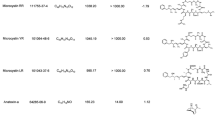Abstract
Phycotoxins produced by various species of toxigenic microalgae occurring in the plankton are a global threat to the security of seafood resources and the health of humans and coastal marine ecosystems. This has necessitated the development and application of advanced methods in liquid chromatography coupled to mass spectrometry (LC-MS) for monitoring of these compounds, particularly in plankton and shellfish. Most such chemical analyses are conducted in land-based laboratories on stored samples, and thus much information on the near real-time biogeographical distribution and dynamics of phycotoxins in the plankton is unavailable. To resolve this problem, we conducted ship-board analysis of a broad spectrum of phycotoxins collected directly from the water column on an oceanographic cruise along the North Sea coast of Scotland, Norway, and Denmark. We equipped the ship with a triple-quadrupole linear ion-trap hybrid LC-MS-MS system for detection and quantitative analysis of toxins, such as domoic acid, gymnodimine, spirolides, dinophysistoxins, okadaic acid, pectenotoxins, yessotoxins, and azaspiracids (AZAs). We focused particular attention on the detection of AZAs, a group of potent nitrogenous polyether toxins, because the culprit species associated with the occurrence of these toxins in shellfish has been controversial. Marine toxins were analyzed directly from size-fractionated plankton net tows (20 μm mesh size) and Niskin bottle samples from discrete depths, after rapid methanolic extraction but without any further clean-up. Almost all expected phycotoxins were detected in North Sea plankton samples, with domoic acid and 20-methylspirolide G being most abundant. Although AZA was the least abundant of these toxins, the high sensitivity of the LC-MS-MS enabled detailed quantification, indicating that the highest amounts of AZA-1 were present in the southern Skagerrak in the 3–20 μm size-fraction. The direct on-board toxin measurements enabled isolation of plankton from stations with high AZA-1 levels and from the most suspicious size-fraction, i.e. most likely to contain the AZA-producer. A large number (>100) of crude cultures were established by serial dilution and later screened for the presence of AZAs after several weeks growth. From one crude culture containing AZA, a small dinoflagellate was subsequently isolated and brought into pure culture. We have thus proved that even sophisticated mass spectrometers can be operated in ship laboratories without any limitation caused by vibrations of the ship’s engine or by wave movement during heavy seas at wind forces up to nine Beaufort. On-board LC–MS–MS is a valuable method for near real-time analysis of phycotoxins in plankton for studies on bloom dynamics and the fate of toxins in the food web, and for characterization and isolation of putatively toxigenic organisms.



Similar content being viewed by others
References
Hummert C, Rühl A, Reinhardt K, Gerdts G, Luckas B (2002) Chromatographia 55:673–680
McMahon T, Silke J (1996) Harmful Algae News 14:2
Satake M, Ofuji K, Naoki H, James KJ, Furey A, McMahon T, Silke J, Yasumoto T (1998) J Am Chem Soc 120:9967–9968
Rehmann N, Hess P, Quilliam MA (2008) Rapid Commun Mass Spectrom 22:549–558
James KJ, Furey A, Lehane M, Ramstad H, Aune T, Hovgaard P, Morris S, Higman W, Satake M, Yasumoto T (2002) Toxicon 40:909–915
James KJ, Furey A, Satake M, Yasumoto T (2000) Azaspiracid poisoning (AZP): A new shellfish toxic syndrome in Europe. In: Hallegraeff GM, Blackburn SI, Bolch CJS, Lewis RJ (eds) Harmful algal blooms 2000. IOC of UNESCO, Paris, pp 250–253
James KJ, Moroney C, Roden C, Satake M, Yasumoto T, Lehane M, Furey A (2003) Toxicon 41:145–151
Cembella AD (2003) Phycologia 42:420–447
Moran S, Silke J, Cusack C, Hess P (2007) Correlations between known toxic phytoplankton species and toxin levels in shellfish in Irish waters 2002–2006. In: Proc Int Conf Molluscan Shellfish Safety, Blenheim, New Zealand, in press
Fritz L, Quilliam MA, Wright JLC, Beale AM, Work TM (1992) J Phycol 28:439–442
Seki T, Satake M, MacKenzie L, Kaspar HF, Yasumoto T (1995) Tetrahedron Lett 36:7093–7096
Mallat E, Krock B, Fernández-Tejedor M, Caillaud A, Cañete E, Elandaloussi L, Franco J, Cembella AD, Diogène J (2007) First approach towards the implementation of passive sampling adsorption devices fort the identification of lipophilic toxins in the shellfish monitoring program in the coastal embayments of the Ebro Delta. In: Proc Int Conf Molluscan Shellfish Safety, Blenheim, New Zealand, in press
Hu T, Burton IW, Cembella AD, Curtis JM, Quilliam MA, Walter JA, Wright JLC (2001) J Nat Prod 64:308–312
Aasen JAB, MacKinnon S, LeBlanc P, Walter JA, Hovgaard P, Aune T, Quilliam MA (2005) Chem Res Toxicol 18:509–515
Yasumoto T, Murata M, Oshima Y, Sano M, Matsumoto GK, Clardy J (1985) Tetrahedron 41:1019–1025
Suzuki T, Mitsuya T, Matsubara H, Yamasaki M (1998) J Chromatogr A 815:155–160
Lee J-S, Igarashi T, Fraga S, Dahl E, Hovgaard P, Yasumoto T (1989) J Appl Phycol 1:147–152
Acknowledgements
The authors thank Philipp Hess, Marine Institute, Galway, Ireland, for the supply of an AZA-1 standard and AZA-containing mussel reference material, and Anja These, Federal Institute for Risk Assessment (BfR), Berlin, Germany for AZA LC-MS method details. Technical assistance in the oceanographic sampling was provided by Kai Fiand and Ruben Neuhaus under the direction of Optimare AG. We also thank Captain Hansen and the entire FS Poseidon crew for their technical support and excellent collaboration throughout the entire cruise, along with the help of several AWI graduate students. This cruise was endorsed by the SCOR-IOC Programme GEOHAB as a contribution to the Core Research Project on Harmful Algal Blooms in Fjords and Coastal Embayments. Financial support was provided by the MARCOPOLI research programme of the Alfred Wegener Institute as part of the Helmholz Foundation initiative in Earth and Environment.
Author information
Authors and Affiliations
Corresponding author
Rights and permissions
About this article
Cite this article
Krock, B., Tillmann, U., John, U. et al. LC-MS-MS aboard ship: tandem mass spectrometry in the search for phycotoxins and novel toxigenic plankton from the North Sea. Anal Bioanal Chem 392, 797–803 (2008). https://doi.org/10.1007/s00216-008-2221-7
Received:
Revised:
Accepted:
Published:
Issue Date:
DOI: https://doi.org/10.1007/s00216-008-2221-7




